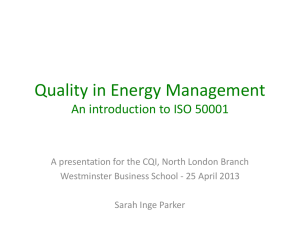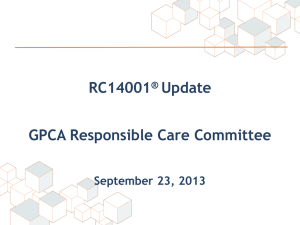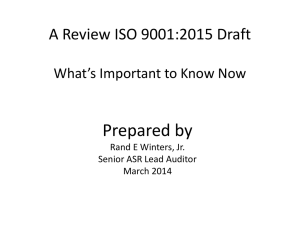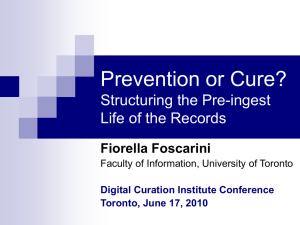ISO 9000
advertisement
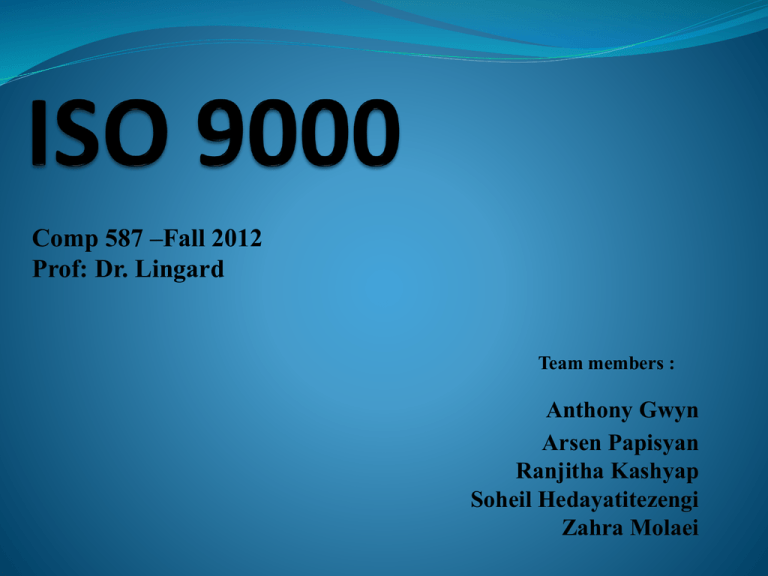
Comp 587 –Fall 2012 Prof: Dr. Lingard Team members : Anthony Gwyn Arsen Papisyan Ranjitha Kashyap Soheil Hedayatitezengi Zahra Molaei Main Goals ISO 9000 was created to produce an international set of process quality standards ISO looks at the process and addresses the methods used during the manufacturing process instead of inspecting the final product Process well documented and agreed upon, then the product will be good ISO 9001:2000 - one of the latest updates Focuses more on improving processes and monitoring customer satisfaction Motivation Started with Britain's Ministry of Defense seeking to reduce mistakes on the assembly line during WWII - Lead to explosions Written procedures that were inspected to ensure consistency Similar quality standards were sought after in the 1960s by NASA and NATO These ideas lead to the BS 9000(Quality Assurance for the Electronics Industry) in 1971 Many revisions followed The Organizations Behind the Effort ISO 9000 standards were published by International Organization for Standardization Influenced by the Department of Defense and the British Standards Institution. When was the Effort Initiated First published in 1987 Based on BS 5750 series of standards from the British Standards Institution that were proposed to ISO in 1979. Who uses ISO 9000 Department of Food and Drug Administration, Energy, Defense, NASA, GSA Qualcomm, Cisco, IBM Adopted by the US as The American National Standards Institute (ANSI)/ASQC Q90 series US motor carrier industry Fed-Ex Banking, Healthcare, Manufacturing, Software, Service, etc. Main Features of ISO 9000 Objective: "To promote the development of standardization and cooperation in the spheres of intellectual, scientific, technological and economic activities" ISO 9000 – concepts behind the management systems It is a set of standards for quality management and quality assurance ISO 9001 - Model for Quality Assurance in Design/Development, Production, Installation, and Servicing Generic Consistency between processes and results. Internal and external benefits Main Features of ISO 9000 It is based on eight Quality Management Principles Customer-Focused Organization Leadership Involvement of people Process Approach System Approach Factual Approach Continual Improvement Mutually beneficial supplier relationship Customer satisfaction from design through service. Relationship, Similarities, or Differences of ISO 9000 with other Approaches Relationship between CMMI and ISO 9000. CMMI is a model specifically designed for development, with some focus on software development. It gives very concrete guidance on what to do (not how to do). ISO 9000 is a generic model, and although there are related software specific interpretation guidelines, and although the last revision ISO 9000-2000 is more process oriented than previous versions, we find CMMI a much more helpful model, if your core competence is software development. Relationship, Similarities, or Differences of ISO 9000 with other Approaches Difference between the Baldrige Award and ISO 9000 The purpose, content, and focus of the Baldrige Award and ISO 9000 are very different. The Baldrige Award was created by Congress in 1987 to enhance U.S. competitiveness. The award program promotes quality awareness, recognizes quality achievements of U.S. organizations, and provides a vehicle for sharing successful strategies. The Baldrige Award criteria focus on results and continuous improvement ,and the relationship between the Baldrige Award and ISO 9000 registration is widely confused. Two common misperceptions stand out: (1) that they both cover the same requirements and (2) that they both address improvement, relying on high quality results, and thus, are both forms of recognition. Relationship, Similarities, or Differences of ISO 9000 with other Approaches Relationship between ISO 9001 series and ISO/IEC 15504. ISO 9001 is a general quality system standard. It has been designed to be used in a third-party audit mode where the organization’s quality system is audited against the requirements set out in the standard. If the organization meets all the ISO 9000 requirements (pass-fail mode), it is given a 9000 certificate. ISO/IEC 15504 is an emerging software standard on software process assessment. ISO 15504 incorporates the intent of the ISO 9000 series to provide confidence in a supplier’s quality management system. However, it goes far beyond that by providing the acquirer with a framework for assessing software suppliers’ capabilities in any of 29 process areas (version 2 of ISO 15504). It also provides guidance on how to carry out process improvement focused self-assessments. Relationship, Similarities, or Differences of ISO 9000 with other Approaches Relationship between Bootstrap and ISO 9000. ISO 9000 is one of the bases of The Bootstrap Project , and it is mentioned in the Article “The BOOTSTRAP Software Process Assessment and Improvement Practice” written by Krzanik, Lech; Similä, Jouni , “The BOOTSTRAP methodology is based on the Software Engineering Institute's maturity model, the ISO 9000 standards, and the European Space Agency process model.” Relationship, Similarities, or Differences of ISO 9000 with other Approaches difference between ISO 9001 and ISO 12207: (1) ISO 9001 is applicable to general systems. ISO/IEC 12207 is applicable to general software products and services, but within the context of a system. (2) ISO 9001 is primarily oriented to the production and manufacturing of hardware and oblivious of software characteristics. ISO/IEC 12207 focuses on the development, operation, and maintenance of software with the necessary links to the parent system. (3) ISO 9001 presents a corporate view of quality. ISO/IEC 12207 presents a functional view of life cycle. Relationship, Similarities, or Differences of ISO 9000 with other Approaches (4) ISO 9001 consolidates the activities related to quality system. It does not fully cover management and technical activities related to system engineering or software engineering. ISO/IEC 12207 consolidates all known activities in a life cycle, including management, technical, and quality assurance. The terms "design/development" do not mean the same in ISO 9001 and ISO/IEC 12207. The differences, however, are not precisely clear. (5) ISO 9001 addresses compliance with general process(es). ISO/IEC 12207 addresses compliance with applicable processes. (6) ISO 9001 is primarily used in determining the capability of a supplier's quality system. Relationship, Similarities, or Differences of ISO 9000 with other Approaches The set of practices in the Trillium model is built using the following algorithm: (ISO 9000 and Trillium model ) Practices are taken from the SEI CMM Version 1.1. ISO 9001 and ISO 9000-3 clauses are mapped to this set of practices and where possible, practices are modified to integrate these requirements ,so All remaining ISO 9001 and ISO 9000-3 clauses (i.e., which could not be mapped) are added to the set of practices. Relationship, Similarities, or Differences of ISO 9000 with other Approaches differences between two quality standards, ISO 9001 and Six sigma: ISO 9001 and Six Sigma are, however, complementary. ISO 9001 (and its derivative standards) tells you WHAT has to be done; Six Sigma tells you HOW to do it. Or in details: A. ISO 9001 is a management system standard. B. Six-sigma is a statistical description of process performance. Relationship, Similarities, or Differences of ISO 9000 with other Approaches A. ISO 9001 focuses organization’s on their management system that governs the processes that yield products. At the system level ISO 9001 is inviting organizations to address common (system level) causes of process variation. The process-based management systems specified by ISO 9001 can be used to assure product quality and manage continual improvement (to add value faster and prevent loss sooner). B. Six-sigma is a continual improvement methodology. Six-sigma focuses on designing products so they can be made with fewer defects and on running projects to progressively remove the most costly assignable causes of process variation. Many organizations mistakenly focus their six-sigma efforts on manufacturing before product design. Six-sigma literally means 3.4 defects per one million products. I understand that US airlines with the FAA run their safety processes at about 7-sigma. Opinion about ISO 9000 Increasing sales and reducing cost are the two importance that make a production line successful and it applies to software production as well. However, If the quality of the service or product is not acceptable no matter how low the cost and how high the sales would be yet there will not be any profit and as a result the product or service will not be successful. However, by bringing the benefits of ISO 9000 to an organization , the products will have continuous improvement. Some of those benefits are obtaining management commitment , Creating an implementation team , Communicating the goals of the program and provide training , mapping out the most critical processes of the current system , and many more. Therefore , ISO 9000 will help to have a successful product or service. References http://www.systemsthinking.co.uk/3-1-article.asp http://en.wikipedia.org/wiki/ISO_9000 http://www.getiso.co.uk/history.html http://www.british-assessment.co.uk/articles/iso-9001-dispelling-the-myths.htm http://www.iso.org/iso/home/store/publications_and_eproducts/publication_item.htm?pid=PUB100208 http://en.wikipedia.org/wiki/ISO_9000 http://www.enotes.com/iso-9000-reference/iso-9000 http://asqgroups.asq.org/divisions/soft/newsletter/Newsletter%20Archive/14858%20No3%201 997-8.pdf http://www.pjr.com/standards/iso-90012008/benefits-of-iso-9000/ http://seweb.cit.gu.edu.au/trillium/t3modc3.html article “UNDERSTANDING THE IMPORTANT DIFFERENCES BETWEEN THE MALCOLM BALDRIGE NATIONAL QUALITY AWARD AND ISO 9000 REGISTRATION” written by CURT W. REIMANN and HARRY S. HERTZ






